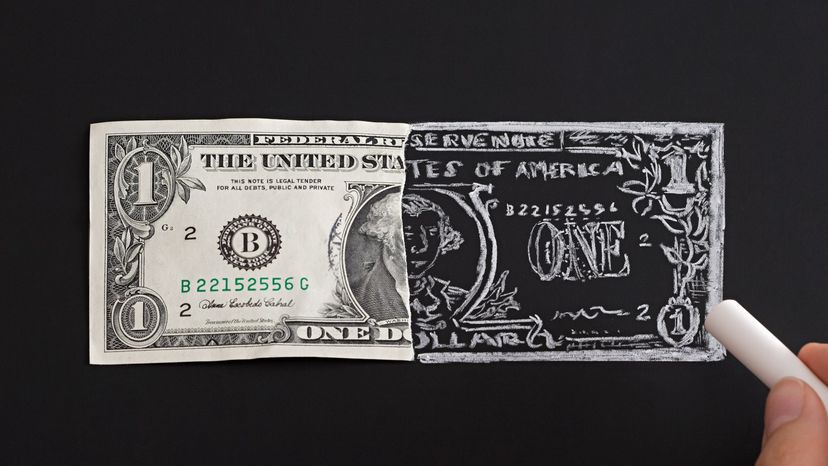
The allure of counterfeiting is obvious. If you could do it without getting caught, you would be able to print your own money and buy whatever you want with it. Counterfeiting is the ultimate technology for people who want to get something for nothing.
In the not-too-distant past, counterfeiting was a difficult and expensive endeavor. It required large printing presses and the ability to cut intricate designs by hand into metal plates. Today, it's much easier to create counterfeit bills. As thousands of teenagers discover every year, if you're willing to break the law, you can create fake money with a computer, a scanner and a color printer in about 10 minutes. Though whether it will pass muster is another story.
Advertisem*nt
In this article, we will look at the technology of counterfeiting. You'll learn about the techniques that you might use if you wanted to create your own counterfeit bills. We'll also discuss the punishment that you will receive when you get caught trying out these techniques. In the process, you will learn how to detect "funny money" yourself and discover whether the U.S. money supply is vulnerable to collapse from a sea of counterfeit bills.
Let's say that you would like to start a life of crime by creating your own counterfeit currency. The easiest way to print your own money is to use your computer. If you own a scanner and a printer, it is pretty easy to get started.
The first thing you would do is put a $20 bill on your scanner. Then you would set the scanner for its highest resolution — perhaps 2,500 or 4,000 dpi — and scan an image of the bill. Your scanner would drop a file on your hard drive, which you'd print out to use as money.
However, your stint as a counterfeiter wouldn't be very successful. The $20 bill that's been in circulation in the United States since late 2003 is one of the high-tech counterfeit-proof bills from the U.S. Treasury. If you zoom in on different areas of the bill and look at them closely, you can see a number of features designed to deter "casual counterfeiting." But first, we'll look at the printing of bills.
Advertisem*nt
Contents
- Printing Cash
- The Importance of Paper
- Getting Around Security Features
- Detecting Counterfeit Money
- Counterfeit Crime and Punishment
- Protecting Yourself from Counterfeit Money
Printing Cash
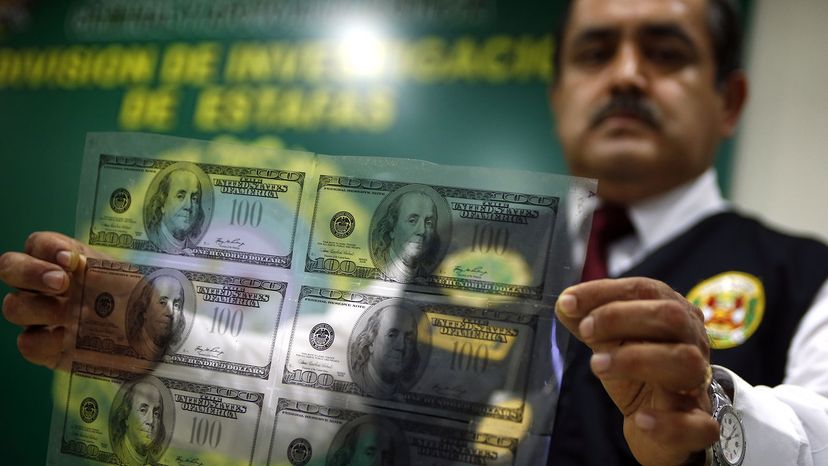
When you try to print your scanned $20 bill, you discover the problem. The fact that the scanner can capture such detail does not mean that your printer is ready to replicate it. If you try printing on a normal inkjet or laser printer, it comes out looking all wrong to the naked eye. The colors are off and the images look muddy.
You can see why it looks wrong when you put your new counterfeit bill under a microscope. On a legitimate $20 bill, the hexagon patterns are light green and fine-lined. An inkjet printer can't replicate those fine lines, so they run together producing a much brighter green hue.
Advertisem*nt
To some extent, these printer problems can be remedied with a better printer. However, even the best printers lose some of the detail. If you were to look at the inkjet printer's counterfeit bill with a magnifying glass, it would be obvious that it is a counterfeit. But to the naked eye, a good high-resolution printer can produce a counterfeit bill that looks pretty close to the real thing.
To create an actual bill, you are going to have to test-print your scan a number of times and adjust the color to get the overall tone right. You are also going to have to scan the back of the bill and practice aligning the front and back sides to get a realistic two-sided bill.
If you are careful with your technique and if you have a good enough printer, you will end up with a bill that, although not perfect, looks passably good to the naked eye. It won't have the color-shift ink and it will look a bit muddy in places, but as long as the recipient doesn't look at these details very closely, the illusion will be "good enough" to work.
The easiest way to get around the visual imperfections of your counterfeit bills is to spend the bills in situations where the exact visual details are hard to see. For example, you might try to hand your fake money to a waitperson in a darkened bar or nightclub.
But as soon as the person touches the counterfeit money, it will be obvious that something is wrong. That's because of the paper.
Advertisem*nt
The Importance of Paper
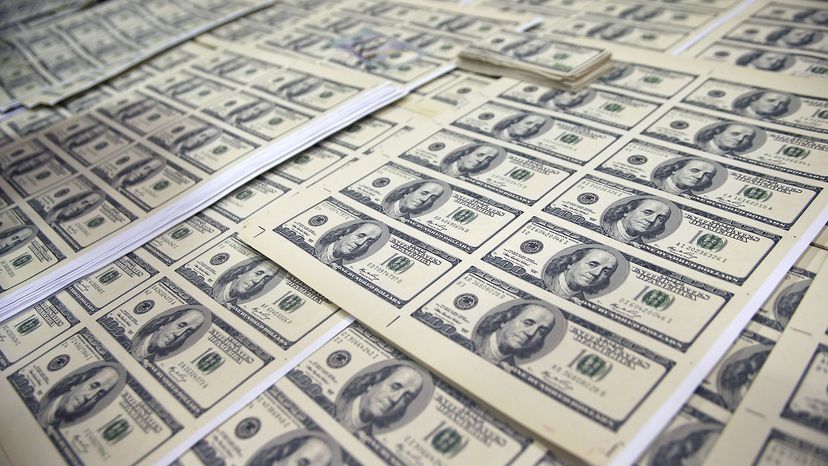
People know what money feels like. People who handle money constantly, like bank tellers, cashiers and waitstaff, can feel a counterfeit bill instantly if the paper is wrong.
That "feel of money" comes from at least three different things that make the paper in paper bills unique:
Advertisem*nt
- Normal paper that you use on a day-to-day basis (newspaper, notebook paper, paper in books, etc.) is made from the cellulose found in trees. Paper used for money, on the other hand, is made from cotton and linen fibers. This kind of paper is known as rag paper. One big advantage of using rag paper is the fact that it does not disintegrate if you accidentally run paper money through a washing machine.
- The paper used for money is thin compared to normal paper.
- The paper used for money is squeezed with thousands of pounds of pressure during the printing process. This makes it even thinner and gives newly made bills a special crispness.
The other special thing about the rag paper used in real money is that there are tiny blue and red fibers mixed into the paper when it is made. These fibers are easy to find in real money, but they are so fine that they do not reproduce very well in the counterfeit money from your inkjet printer.
The last thing a counterfeiter wants to do is print counterfeit money on "normal" printer paper. It will feel all wrong, and it can be detected with a counterfeit pen. These special pens, which often look something like a highlighter, contain iodine that changes color when it comes in contact with cellulose. At the very least, you need to try to find thin rag paper to print on. You can find this kind of paper at most office supply stores.
However, the paper still may not feel right. That's why some counterfeiters go the extra mile to get the perfect paper. The ultimate counterfeit bill would use the same paper used by the government. This paper, however, is nearly impossible to buy. It's not sold commercially.
One of the most popular counterfeiting methods, used for decades by Colombian drug cartels and small-time scammers, is to bleach lower-value bills like $1 and $5 notes and reuse the original paper to print $100 bills. A skilled counterfeiter can even retain the original serial numbers from the $1 and $5 bills for added authenticity. Colombian counterfeiters use expensive offset printing machines to create authentic-looking (and feeling) bills, while other counterfeiters have printed millions of dollars in fake money from their inkjet printers using bleached bills.
Advertisem*nt
Getting Around Security Features
The $20 bills printed by the Treasury since 2003 contain three special security features that are impossible to fake with an inkjet printer:
- A plastic security strip is embedded in the paper and runs vertically up one side of the note. If President Andrew Jackson is facing you, then the plastic strip is on the left side. Upon close inspection of this security strip, you can see the words "USA TWENTY" and a small flag repeated along the thread. This should be visible on both sides of the bill. The thread also glows green when exposed to ultraviolet light.
- Located in the bottom right corner on the face of the bill, the number "20" is made of color-shifting ink. If you tilt the bill back and forth, the number "20" shifts from copper to green.
- A faint and smaller version of Jackson's portrait (as seen on the face of the bill) is "hidden" within the paper itself as a watermark. If you hold the bill up to a light, the watermark is immediately evident from either side of the bill.
In 2013, the Treasury issued a new $100 bill with several few more hard-to-fake security features:
Advertisem*nt
- A new 3D security ribbon is embedded into the $100 bill in addition to the regular security ribbon. The 3D ribbon is blue and is printed with shape-shifting images of the Liberty Bell that become "100" when tilted back and forth.
- There's a copper-colored inkwell on the front of the $100 that contains a color-shifting image of the Liberty Bell. When you tilt the bill back and forth, the bell changes from green to copper and seems to disappear in the inkwell.
- The bill is also microprinted with tiny lettering around Benjamin Franklin's collar reading "The United States of America" and on a copper-toned quill in the background reading "USA 100."
Other U.S. bank notes have similar security features.
Advertisem*nt
Detecting Counterfeit Money
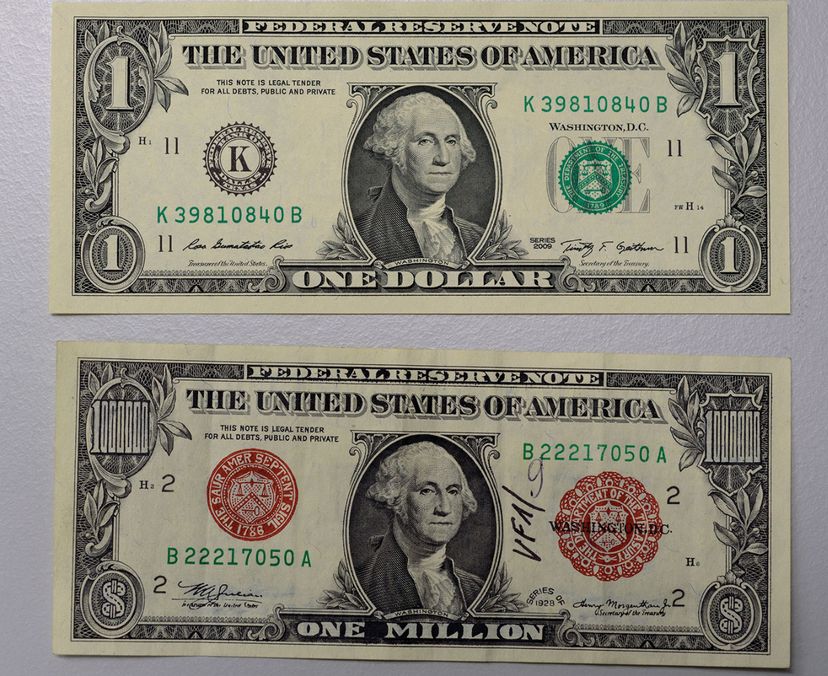
Less than 0.01 percent of all U.S. currency in circulation is counterfeit, according to the U.S. Federal Reserve, but even 1 out of every 10,000 bills adds up quickly when there are more than 50 billion notes in circulation worth more than $2 trillion. The U.S. Secret Service is the federal agency in charge of finding and arresting counterfeiters, but there are several safeguards built into the monetary system for detecting fake bills.
Federal Reserve banks are the first checkpoint for counterfeit money. Federal Reserve banks are responsible for supplying currency to commercial banks, and that goes for new bills as well as "recirculated" bills. The Federal Reserve doesn't disclose its methods, but it has its own scanning and detection systems for weeding out fake money.
Advertisem*nt
Commercial banks are another place where counterfeit bills are detected. Tellers and other bank staff are trained to spot counterfeit money by feel, look and a quick scan of the hidden security features.
Retail stores and businesses are the most vulnerable to counterfeit money. If a business accepts a phony bill and deposits it in their bank account, the bank will detect it and charge the business owner for the missing amount. Cash register workers are trained to spot fake bills by holding them up to the light to see the embedded security strip and looking for color-shifting text.
If you or your business receive a bill that you suspect is counterfeit, call the police or report it to the Secret Service through the U.S. Dollars website.
Advertisem*nt
Counterfeit Crime and Punishment
Counterfeiting is not a minor offense. It is not like running a red light, or even shoplifting. These crimes are misdemeanors handled at the local level by local police and courts. Counterfeiting, on the other hand, is a federal felony handled by the U.S. Secret Service. In fact, the entire reason the Secret Service was originally created was to handle counterfeiters. Only later did it take on the role of additionally protecting the president and other key government officials.
The reason why counterfeiting is treated as such a serious crime is because money is so important to our society. Money is the oxygen of the economy. If people cannot trust that the money they carry is authentic, then it gets much harder to buy things and the economy slows down.
Advertisem*nt
When you get caught counterfeiting — and if you are counterfeiting you will eventually get caught — the punishment can be quite harsh. According to federal law, someone convicted of counterfeiting U.S. currency is subject to fines as high as $250,000 or up to 20 years in prison. In reality, most counterfeiting operations are small — in 2020, more than half of all counterfeiting convictions were for amounts less than $6,500 (the median loss was $4,600) — and the sentences are lighter. The average counterfeiting sentence in 2020 was 18 months, according to the Secret Service. If fines and jail time aren't enough to deter you, there are additional penalties as well.
Authorities will also seize any property used to create or pass the bills. That means your computer, printer and scanner will be confiscated. In other words, the picture is pretty clear. When you create counterfeit bills, you will get caught. There are a ton of people out there looking for fake bills because they don't want to get ripped off. When you get caught, the penalties will be severe, and it's likely you will end up spending some time in jail. You will have a federal felony arrest on your record, making it very hard to get a job.
In other words, you can't get something for nothing, at least not if you are trying to do it by counterfeiting. Although it is easy to print your own money, you'll probably get caught when you try to spend it.
Advertisem*nt
Protecting Yourself from Counterfeit Money
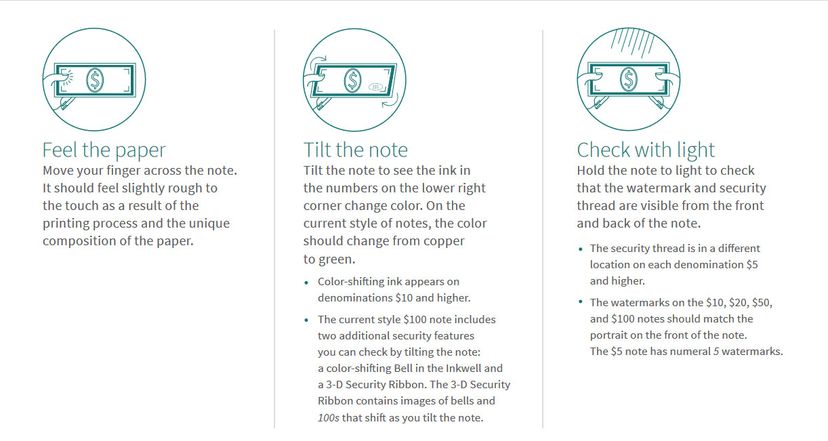
Whether you are a normal person taking your change at a store, or you are a merchant accepting cash in your business, you need to be aware of the counterfeiting problem. Here are several steps you can take to protect yourself:
- Be vigilant; take time to look at and feel the money you receive. Remember, the paper used to make genuine bills is not available commercially, so it feels "off," that is a big giveaway. The paper texture should feel like cotton and fiber and have slightly raised ink.
- Look at bills in the light. The color-shift ink is very hard to fake. The security stripe and watermark are impossible to duplicate with a home printer. In black light, the security thread should glow on an authentic bill.
- With multiple large bills, check for duplicate serial numbers. Also look to see that the serial numbers are evenly spaced.
- Be especially suspicious of older bills (those bearing old pre-1996 designs) and bills of larger denominations.
- If you believe you are receiving a counterfeit bill, call the police.
A lot of work has gone into creating bills that are hard to counterfeit. If you use the new security features, it should be easy to detect counterfeit bills.
Advertisem*nt
Counterfeiting FAQ
Is counterfeiting a federal crime?
Counterfeiting is a major offense and federal crime, handled by the U.S. Secret Service. In fact, the original purpose of the Secret Service was to catch counterfeiters. It was only later that they took on other responsibilities.
How can you tell if money is counterfeited?
You can detect counterfeit money if it is done by novices, but it’s harder for the average person to tell if it’s been done by a professional. If a bill is fake, the paper may have a slightly different texture or thickness, the colors may be slightly off or it may not have a watermark when held up to the light.
What is the meaning of counterfeit?
Counterfeiting refers to the imitation of something authentic, with the malicious intention of destroying, stealing or replacing the original. This way, it can be used to deceive individuals during illegal transactions.
How much jail time do you get for counterfeiting?
Counterfeiting can have a sentence of up to 20 years in prison. A person may also be required to pay penalties and authorities may seize the property used for creating or distributing the fake bills.
What type of crime is counterfeiting?
The federal law categorizes counterfeiting as a class C felony, which can result in a prison sentence of up to 20 years and a fine as high as $250,000. Some states' laws have their own penalties for counterfeiting as well.
Lots More Information
Related Articles
- How Currency Works
- How ATMs Work
- How Credit Cards Work
- How Banks Work
- How the Fed Works
- How the Euro Works
- How to Organize Your Taxes and Money